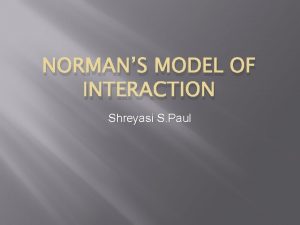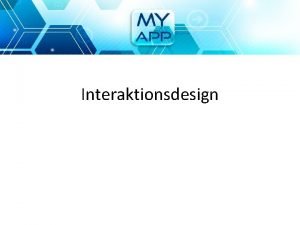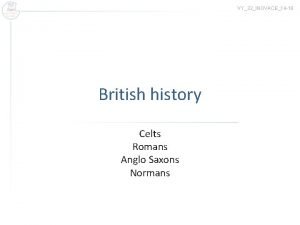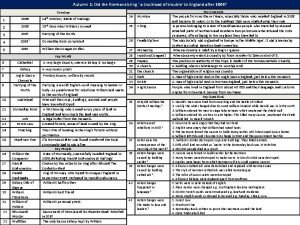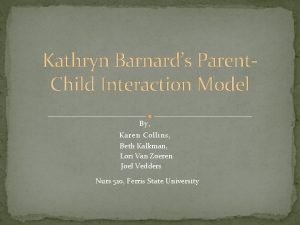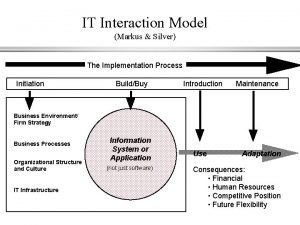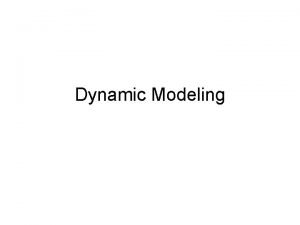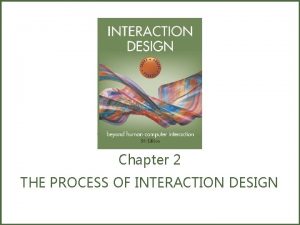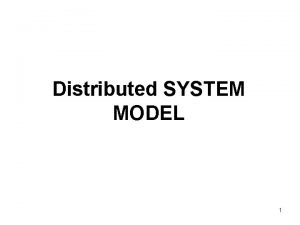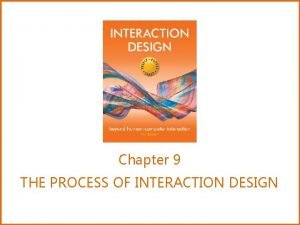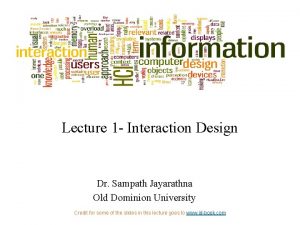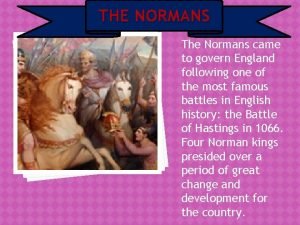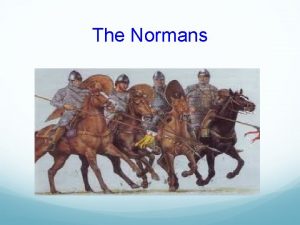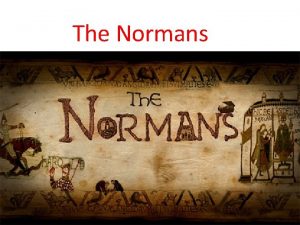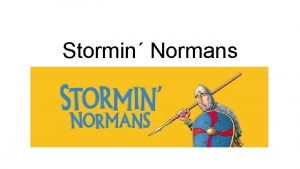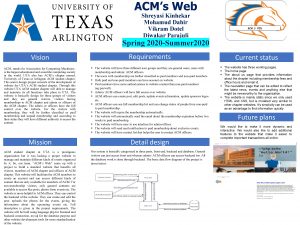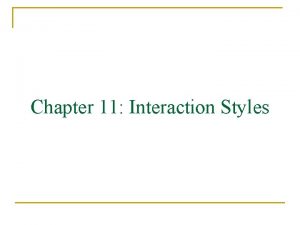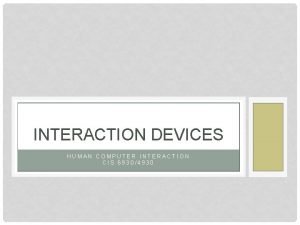NORMANS MODEL OF INTERACTION Shreyasi S Paul Introduction
















- Slides: 16

NORMAN’S MODEL OF INTERACTION Shreyasi S. Paul

Introduction � � � � Let us first understand the word “ INTERACTION” All man-made objects offer the possibility for interaction. When an object is designed for a purpose (function) it affords interaction. Interaction is a way of framing the relationship between people and objects designed for them. Interaction is thus a way of framing the relationship between the object & User. All Design activities can be viewed as design for interaction. In fact not only objects but space & messages ( communication) too involve interaction. Interaction is a key aspect of function, and function is a key aspect of design. However often one notices that designers often use the word ‘INTERACTION’ rather carelessly. Interaction starts with getting to know the users and their context: � � � finding out who they are and what they are like. . . probably not like you! talking to them, watching them.

Cont… Untrained Designers often tend to confuse ‘Interaction’ with ‘ Reaction’. For example: Designers claim to be designing “ Interactive web pages”. The fact is clicking on links to navigate to a new webpage is NOT “ INTERACTION”. It is ‘reaction’ of input by the hyperlinked pages. The computer is automatically reacting to input because it has been programmed to do so. This programmed action couples ‘ input’ to ‘ output’ in a fixed way. Interaction is however a dynamic action that through a dialogue (involving feed back) adjusts to input and gives appropriate output. In HCI -Interaction is simply stated as two way communication between

Definitions of some Terms of Interaction Domain: expertise, knowledge in some real world. Activity. In GUI domain concepts such as geometric shape, color, Task: operation manipulate concepts in a domain. Symbols etc are to involved. Goal: desired output from a performed task. Ex in GUI: A button. Intention: specific action required to meet the goal Task analysis: Study of the problem space. Definitions of some Terms of Interaction.

� � � � In HCI interaction models are translations between user and system. There are different Interaction Models mentioned in HCI. Donald Norman’s Interaction Model Abowd& Beale’s model A generalized Interaction Model (from Dix et al) has four components: (i) System; (ii) User; (iii) Input & (iv) Output. There are different Interaction Styles (nature of the dialogue) And there are different Interaction Contexts (Social, Organizational, Educational, Commercial etc)

Norman’s Model of Interaction � � Donald Norman’s Interaction model concentrates on the Users Thought processes and accompanying actions. Norman proposed that actions are performed by the users in cycle such as � Establishing a goal � Executing the action � Evaluating the results � � Given a need a user sets about achieving the goal of fulfilling the needs. A series of actions are performed –one leading to another –till the result expected is obtained.

Norman’s Model of Interaction � Norman’s Model of Interaction consists of seven stages as follows:

Another way of depicting Normans 7 stage Action model

Understanding Normans Model with Example � � � Need: Documenting work done Task: Save My Sketch Goal: Safely store the sketch in a place which I can fetch it from.

Norman’s HCI model � Norman’s HCI model consists of three types: � � � � User’s Mental Model ; System Image Model ; Conceptual Model. The User’s Mental Model is the model of a machine’s working that a user creates when learning and using a computer. It is not technically accurate. It may also be not stable over time. User’s mental models keep changing , evolving as learning continues. In a way Mental Models are models people have of themselves, others and environment. The mental model of a device is formed by interpreting its perceived actions and its visible structure. The System image Model is the visible physical part of the computing system / device.

� � � This is the technically accurate model of the computer / device / system created by designers / teachers/researchers for their specific internal technical use. Users too have a Conceptual model but it is their mental model unless the user is a technically qualified as the evaluator. In a way as far a the user is concerned mental models and conceptual models are inherent to each other. Designer’s too have Mental models of the system. So a Conceptual model of the system needs to be as close as possible to the System’s Image Model. The User model (what the user develops in the self to explain the operation of the system) and the system image (the system’s appearance, operation way it responds) is usually a blend of the users mental model and conceptual model all rolled into one.

Interaction Model and device /system Design � � A good device / system will emerge when the starting point of the design process is the userhis/her mental model’ ( in turn derived through user research-task analysis , walk thoughts Contextual inquiry etc) being the basis of the system image and its conceptual model The Conceptualisation of the Designer had in his/her mind is called the design model. Ideally, the design model and user model have to be as close as possible for the systems acceptance. The designer must ensure that the system image is consistent with and operates according to the proper conceptual model.

Norman applies the Model to explain why some interfaces cause problems to the users � � He uses the terms “Gulf of execution’ and ‘ Gulf of evaluation’. Normans model (also some times called as Gulf Model) is useful in understanding the reasons of interface failures from the users point of view. The Seven stages of action model is an elaboration of the Gulf model. Gulf of Execution represents the difference between user’s formulation of the action to reach their goals and the actions allowed by the system. User’s formulation of action = Actions allowed by the system.

� � The Gulf of Evaluation is the difference between physical presentation of system state and the expectations of the user. User’s Expectation = system’s presentation.

Interaction Styles � � � Having understood Interaction Frame work as a model let us Look at Interaction Styles Some common interaction styles Command line interface Menus Natural language Question/answer and Query dialogue (Ex: SQL) Form-fills and spreadsheets • WIMP –[ Windows; Icons; Menus; pointers] � Three–dimensional interfaces � � � � Gestural Interfaces Vice operated commands Thought (mind) operated commands (Evolving rapidly at Laboratory level)

Assignments � � Draw the Users Mental Model for a Transfer of Money from one account to another on an ATM Using Normans seven principles draw a Normans Interaction Diagram for 2 Tasks in any application software of your choice.
 Norman interaction model
Norman interaction model Gestaltlove
Gestaltlove Where did the normans come from
Where did the normans come from Celts romans anglo saxons vikings normans
Celts romans anglo saxons vikings normans What changes did the normans bring to ireland
What changes did the normans bring to ireland Did the normans bring a truckload of trouble
Did the normans bring a truckload of trouble Where did the normans settle in ireland
Where did the normans settle in ireland Kathryn barnard metaparadigma
Kathryn barnard metaparadigma It interaction model in mis
It interaction model in mis Uml interaction diagram
Uml interaction diagram Interaction design lifecycle model
Interaction design lifecycle model Lifecycle model of interaction design
Lifecycle model of interaction design Interaction diagram in software engineering
Interaction diagram in software engineering Distributed system models
Distributed system models A simple interaction design lifecycle model
A simple interaction design lifecycle model Kathryn barnard child interaction theory
Kathryn barnard child interaction theory A simple interaction design lifecycle model
A simple interaction design lifecycle model
